Dive Training Blogs
Dive to Survive: How much do you value your life?
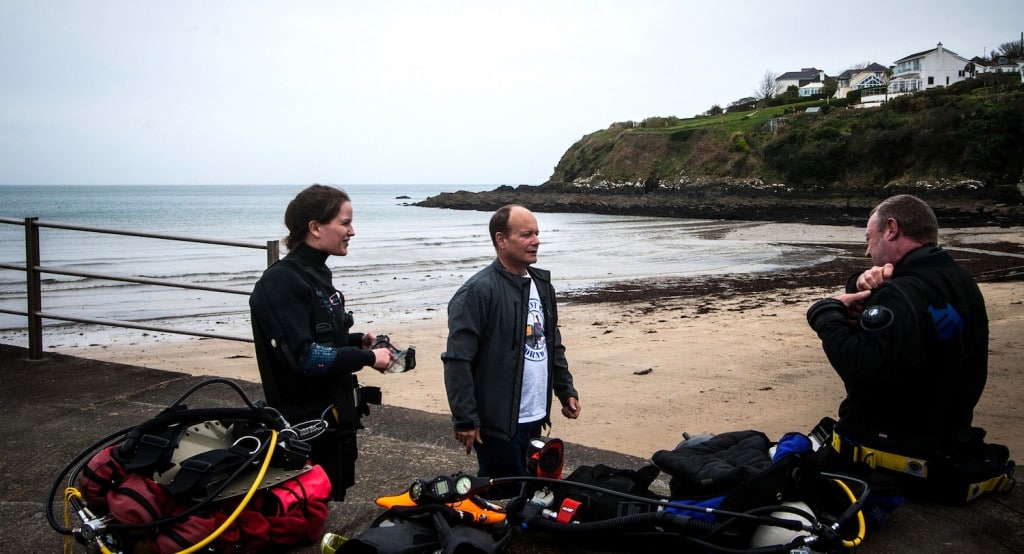
In her first blog for Scubaverse, Underwater Photographer and RNLI Editor Anna ‘Nudi’ Burn reports on her experience of the RNLI Diver Sea Survival specialty course…
Just Another Specialty?
Divers who are a bit longer in the tooth often talk sceptically about collecting qualifications and cards but, after commercial fishermen, we are the second most at-risk group around our coasts (based on fatality rate). 68 divers lost their lives in UK waters between 2012 and 2016 (2016 Annual Diving Incident Report) and taking steps to improve our survivability, should the worst case scenarios arise, is essential.
I’ve been diving for 12 years and have always been pretty comfortable in the water but, because of the work I do for the RNLI, I’m all too aware of how easily things can go wrong – and also how often it seems to happen to people who are experienced.
The RNLI has worked with the British Diving Safety Group (BDSG) to develop a sea survival course for divers of all levels, now available through PADI, SSI, SDI and RAID. There’s also a club-based version, the diver sea survival workshop with BSAC, IUC and SAA. I booked on to the PADI course with Viewpoint Diving Centre in Pentewan, south Cornwall.
The course takes you through lifesaving safety skills and kit, as well as brushing-up on dive planning (tide states, entry and exit in tricky conditions, navigation and methods of maintaining contact in low vis). Diving safety guru Mark Powell helped develop its content and features on the training videos, alongside dive professionals from Mulberry Divers in Selsey, and RNLI crew members Mark says of the course: “It provides not only a reminder of key safety aspects, but also teaches you new safety skills.”
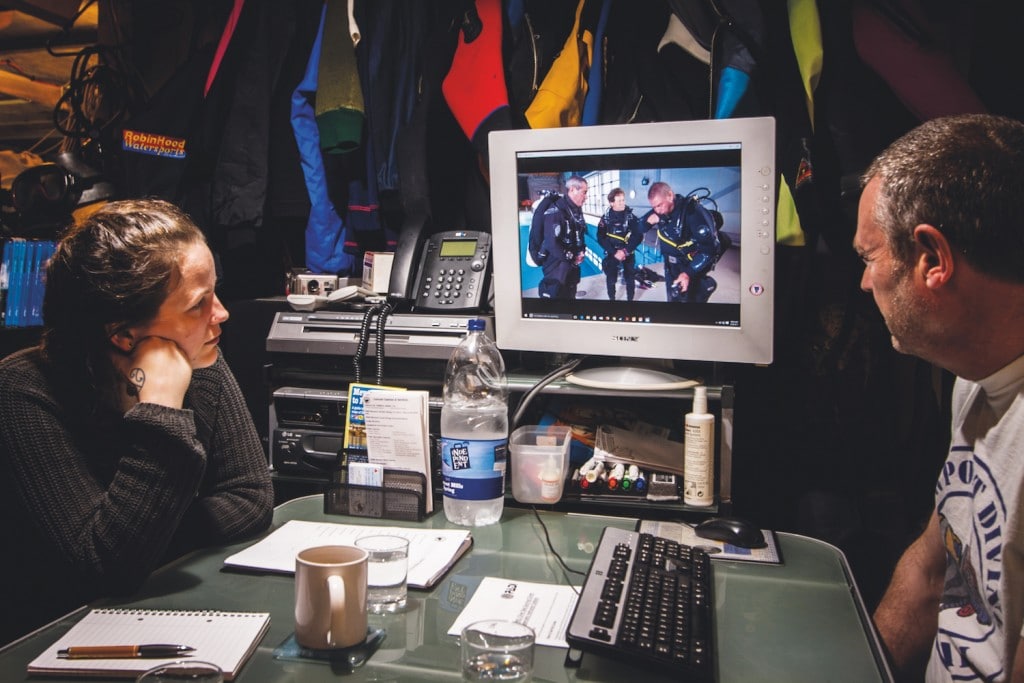
Mark Powell presents a module of the RNLI Diver Sea Survival course. Credit: Niki Holt
Instructor, Mike Morris, got us hands-on with varied safety kit, sharing his own stories of mishaps and close calls as we went through the modules. I found this really made a difference to the course and Dive Centre Owner Dave Skinner agrees: “If you’ve got someone who’s been teaching for a long time then you can get quite a lot from this; the instructor can put their own experience into it.”
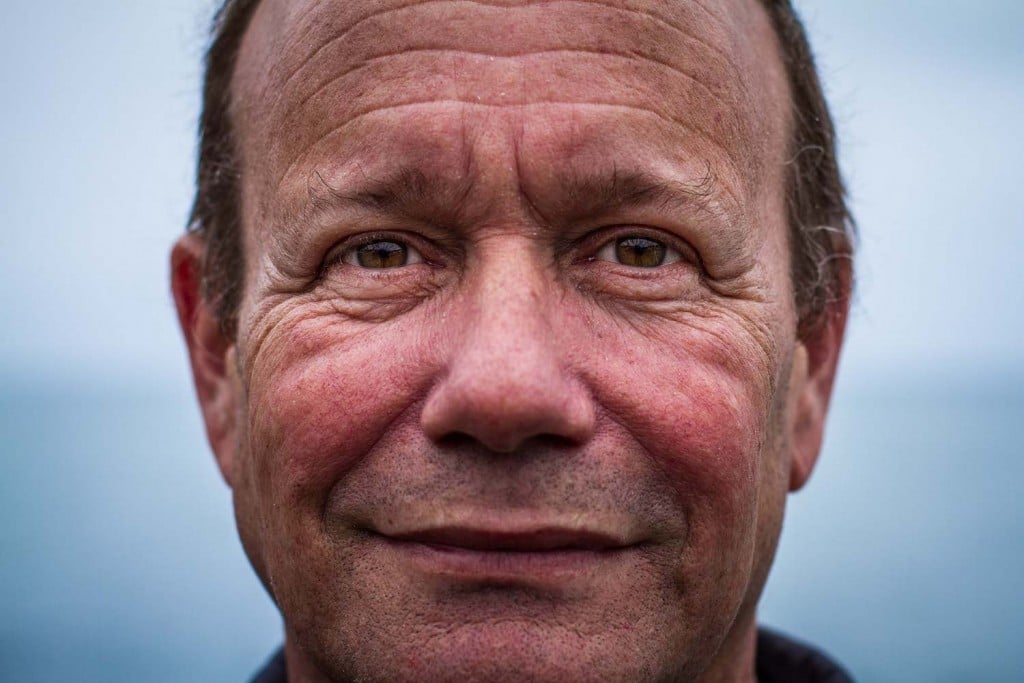
Dave Skinner, Owner of Viewpoint Diving, Pentewen, Cornwall. Credit: RNLI – Anna Burn
In the water, I had the opportunity to practice survival skills, try out the safety devices and reflect on my own diving. With the kind of ‘safe’ and easy UK shore diving I tend to do, two areas stood out where my own safety considerations had been overlooked.
1. Rethinking Diveable Vis
We’re used to considering underwater visibility but give less thought to our own. What’s an acceptable level of visibility for you, based on the risk?
Consider being caught in a current and the light dropping before you’re found. Will the RNLI and coastguard crews be able to spot you as a speck in a vast body of water? Are you satisfied that one DSMB tucked in your pocket will be sufficient?
“It’s amazing to me how many divers go into the water without visible aids. The light has gone before we actually find them and it’s extended the search overnight and into the next day. If they’d had those aids, we may well have found them before we lost the light.”
Martin Rudwick, Coxswain at Selsey Lifeboat Station
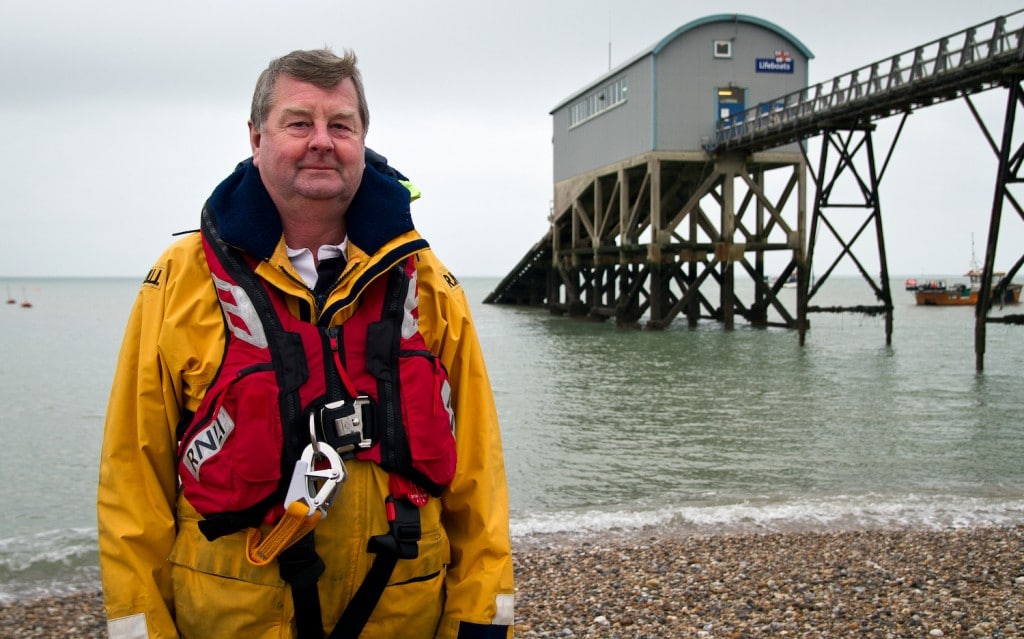
Martin Rudwick – Coxswain, Selsey Lifeboat Station. Credit RNLI – Nathan Williams
Some simple changes you can make to increase surface visibility inexpensively are: carrying a strobe to draw attention and dye to leave a trail for rescuers, wearing kit that is brightly coloured, and hanging a weight just below your DSMB to keep it upright.
Us divers tend to like functional understated black gear. But if we’re serious about functionality, visibility is a key consideration. Our shore cover had no trouble spotting our bright orange hoods compared with the usual black pinprick of neoprene, so I now have some soul searching to do!
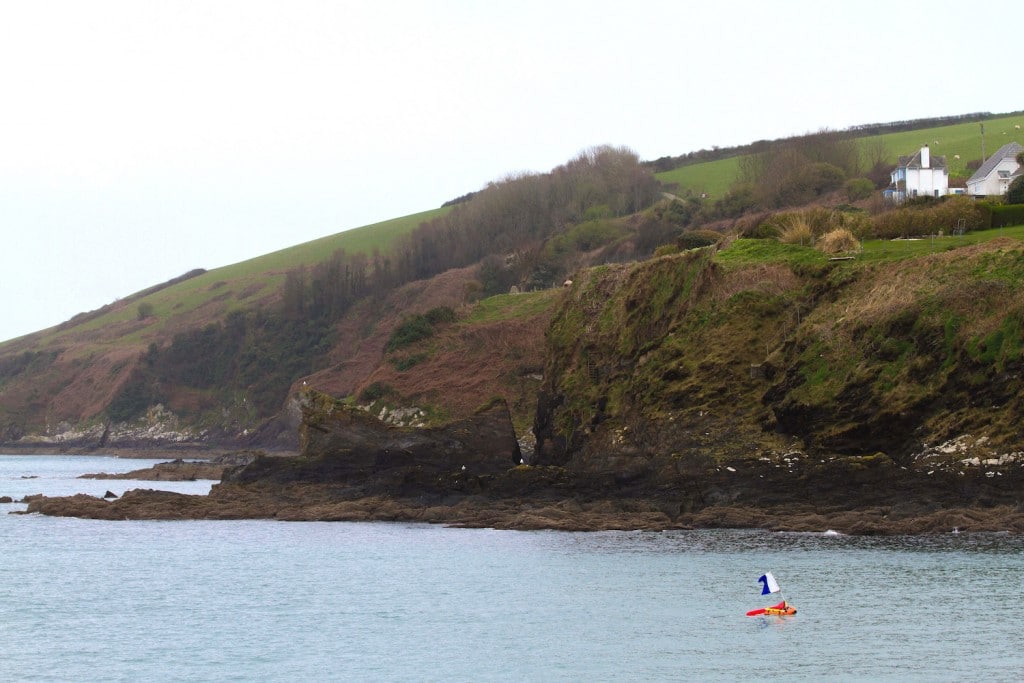
RNLI Diver Sea Survival, Viewpoint Diving, Cornwall – Diving visibility. Credit: Niki Holt
2. What’s Your Location?
I dive with a DSMB and whistle, but had no other means of drawing attention to myself should I be pulled away from a dive site by a current. There are two sites I dive where complacency or misjudgment of conditions could lead to that, so this is something I need to rectify.
Carrying a personal locator beacon (PLB) or Nautilus Lifeline marine rescue GPS means crews are more likely to find you. Martin strongly recommends the investment: “If you’re got a PLB, you will be found.”
As an underwater photographer, I already feel like I have quite enough gear dangling off of me! For divers who don’t want to end up looking like a Christmas tree or think they don’t have enough room to carry a PLB, instead of diving without the backup, look at your kit and decide if everything you’re wearing is required. Is that third torch, spool or crab bag really needed?
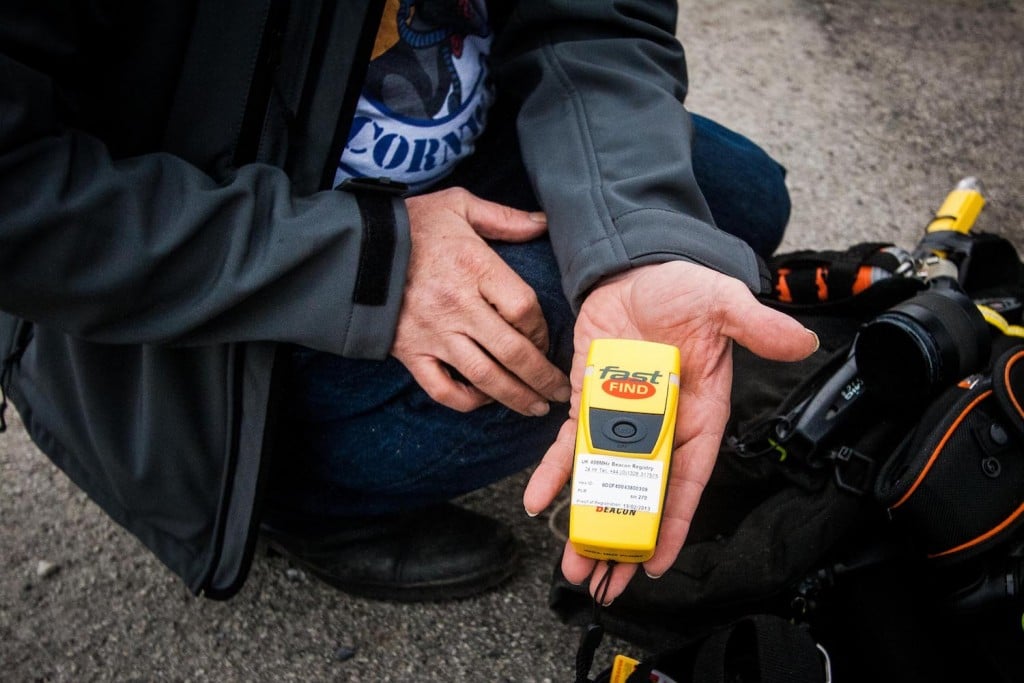
PLB shown by Dave Skinner, Viewpoint Diving, Cornwall during RNLI Diver Sea Survival course. Credit: Niki Holt
How Much Do You Value Your Life?
Many of us think little of dropping some serious money on a new wing, dive computer or trip, but experience a sharp intake of breath when looking at the cost of lifesaving equipment like PLBs and VHF radios. But, with some tragic deaths in our community in just the last 12 months, it’s time to stop and think about what steps we each need to take to prevent further loss.
Please ask your local dive centre about the course or your local club about the workshop. In the meantime, I challenge you to find just one change you can make to increase your chances – should anything ever go wrong.
Safe diving!
For more diver safety advice, visit www.RNLI.org/DiveCourse.
Blogs
Jeff Goodman Launches Underwater Moviemaker Course with NovoScuba

Transform Your Dive Experiences into Cinematic Masterpieces
NovoScuba has partnered with acclaimed underwater filmmaker Jeff Goodman to introduce the Underwater Moviemaker Course—a revolutionary program designed to equip divers with the skills to capture the breathtaking beauty of the underwater world.
Whether you’re an aspiring filmmaker, an avid diver, or a photography enthusiast, this course offers the tools and expertise needed to create stunning underwater videos. From vibrant coral reefs to curious marine life, you’ll learn how to film, edit, and produce captivating underwater stories, all with expert guidance from a seasoned professional.
Jeff Goodman: A Legacy in Underwater Filmmaking
Jeff Goodman brings over 40 years of experience in underwater film production for television to this course. Reflecting on his career, Jeff said:
“Although technology has dramatically changed, the basics of underwater filming remain constant. This course covers crucial skills for producing great videos. Whether you’re creating professional broadcast films or high-quality hobby videos, the fundamental principles are the same.
A camera operator must master their equipment to capture those magical underwater moments effortlessly. But beyond technical know-how, underwater filmmaking is about having fun and enhancing your diving experiences. So, take your time, learn at your own pace, and enjoy this creative journey.”
About NovoScuba
Founded in 2023, NovoScuba is reshaping dive education with a comprehensive, digitally native platform. Offering cutting-edge training programs for divers at all levels, NovoScuba sets a new benchmark in the diving industry by combining innovation with accessibility.
With ISO-certified courses, a student subscription model, and multilingual support, NovoScuba ensures that dive education is inclusive and engaging. More than just a training provider, NovoScuba fosters a global community of divers committed to exploration, collaboration, and sustainability.
Join the NovoScuba Underwater Moviemaker Course Today!
Dive into the world of underwater filmmaking and start creating cinematic stories that inspire. Learn more about the course and enroll today at www.novoscuba.com/novoscuba-underwater-moviemaker-course.
EXCLUSIVE: Jeff Goodman interviews Mark Spiers, CEO of New Scuba Diving Training Agency NovoScuba
NovoScuba’s Game-Changing Approach for Dive Store Owners: WE PAY YOU!
The diving world thrives on passion and adventure, but for many dive store owners, the financial and operational challenges can be as deep as the ocean.
NovoScuba, an emerging force in the diving world, is on a mission to transform this landscape for the better. With a revolutionary approach to dive store and training agency partnerships, NovoScuba is setting new standards for how dive stores can thrive while keeping their focus on delivering exceptional diving experiences.

A New Paradigm: NovoScuba’s Bold Mission
NovoScuba’s mission is straightforward yet profound: to disrupt the traditional dynamics between dive store owners and training agencies. Traditionally, dive stores have been subjected to substantial fees charged by training agencies, for membership, materials and certifications. These costs have often placed a heavy financial burden on store owners, cutting into their profits and limiting their ability to offer competitive prices to customers.
NovoScuba flips the script by offering a model where dive stores earn money, instead of paying high fees. Dive stores receive commissions for every student they register, and their certification costs are covered. This new model not only boosts profitability but also ensures clients get top-quality training at unbeatable prices.
Financial Upsides: Earn From Student Registration
NovoScuba’s approach is simple yet revolutionary. Dive stores partnering with NovoScuba can earn commissions for every student they enroll.
Here’s how it works: For every student enrolled through NovoScuba, dive stores receive a commission. Each student enrolled will receive their e-learning materials and certification credit included in their subscription. This arrangement is a significant departure from the traditional model, where dive stores often struggle to manage high overhead costs related to training fees and certification expenses.

NovoScuba’s approach ensures that dive stores can focus on what they do best—providing top-notch diving experiences—without being bogged down by excessive financial burdens, and the need to carry large stocks of materials.
Quality Training at a Great Price
NovoScuba stands out by offering high-quality, ISO certified, training that doesn’t break the bank, in fact our students will pay less than with most competing agencies. Clients benefit from top-notch education and safety standards at competitive prices. Dive store owners can confidently promote NovoScuba’s programs, knowing they’re offering fantastic training at affordable rates. This balance of quality and affordability helps dive stores build a strong reputation and attract more customers.
Your Brand is Your Business: NovoScuba’s Commitment to Showcasing Your Identity
At NovoScuba, we understand that your brand is your most valuable asset, and we’re committed to putting it front and centre. Unlike agencies that charge high fees to promote their own brand, we believe in investing in yours. With NovoScuba, you won’t be paying to advertise someone else’s logo alone, — our focus is on showcasing your unique identity. Certifications prominently feature your brand, as well as the training agency, reinforcing your store’s image and brand every step of the way. We’re here to support and elevate your brand, ensuring that your investment directly benefits your business.
Affordable Membership: An Investment in Your Success
NovoScuba’s membership model is designed with dive store owners in mind. Membership fees are kept low and include annual Pro member fees for your team. Payment can be made monthly or annually in your local currency, avoiding the hassle of exchange rate fluctuations. NovoScuba promises no exchange rate changes without a six-month notice, ensuring financial stability and simplifying budgeting. With a membership lasting 12 months from date of joining, you’ll enjoy a full year of NovoScuba’s benefits and support.

Streamlined Operations: Simplifying Your Workload
Handling administrative tasks can be a challenge, but NovoScuba makes it easier. We’ve streamlined certification procedures and reduced paperwork to help dive stores operate more efficiently. Certification processing is quick and straightforward, allowing more focus on teaching and customer service. Our system minimises bureaucracy by storing necessary forms in student profiles, reducing paperwork and administrative delays.
Crossover Made Easy
For dive stores looking to transition to NovoScuba’s model, the crossover process is designed to be smooth and hassle-free. NovoScuba provides support to ensure that the transition is as seamless as possible, helping dive store owners integrate into the new system with minimal disruption. Experienced dive Pros don’t need to undergo extensive retraining. Our crossover is designed to familiarise Pros with NovoScuba’s user-friendly platform, standards and course structures, and not to waste time and expense re-training in water.
With just a few simple steps, you’ll be ready to offer top-notch training through NovoScuba.
Comprehensive Business Support and Training Included in Your Membership
NovoScuba goes beyond financial benefits by offering experienced support and training. This value added service includes:
- Business Training: Optimise your operations with guidance on marketing, customer service, and best practices.
- Marketing and Promotion: Access resources to attract new customers and boost your store’s visibility. Enjoy cross promotions with NovoScuba to gain increased exposure.
- Ongoing Support: NovoScuba’s commitment to its partners extends beyond initial training and setup. The company offers ongoing support to address any issues or questions that arise. This continuous support ensures that dive store owners have a reliable resource to turn to whenever they need assistance.

Embracing Digital Natives: Instant Evolution and Continuous Improvement
NovoScuba’s digital-native approach is a game-changer. Leveraging cutting-edge technology, we ensure our services evolve and improve swiftly. Dive stores benefit from instant updates, the latest features, enhancements, and effective solutions, keeping them ahead of the curve. This continuous improvement helps dive stores stay competitive and deliver exceptional services. Whether it’s a new course update, additional marketing resources, or improved e-learning functions, NovoScuba’s digital infrastructure ensures that dive stores are always equipped with the most current and effective solutions. This continuous evolution not only helps dive stores stay ahead in a competitive market but also ensures they consistently provide top-quality services to their clients.
Why Is NovoScuba Doing This? – Fair Profit Sharing for Greater Access and Growth
At NovoScuba, we’ve taken a bold step by paying commissions to stores rather than following the traditional model of training agencies charging high fees. Our mission is to make diving accessible to everyone and to foster a growing community of new divers and continued education. By redistributing profits more equitably between stores and training agencies, we aim to create a more supportive and collaborative environment within the industry. We believe this approach not only helps individual stores thrive but also stimulates overall growth and innovation in diving. Our commitment to fair profit sharing reflects our dedication to the long-term health and expansion of the diving community.

Everyone is getting a piece of the pie.
Getting Started: Join the NovoScuba Revolution
Ready to revolutionise your dive store experience? NovoScuba is here to support your journey toward reduced costs, increased profitability, and enhanced operational efficiency. Get in touch with our team to learn how NovoScuba can transform your business.
For more information, email info@novoscuba.com or visit www.novoscuba.academy.
Blogs
NovoScuba’s Game-Changing Approach for Dive Store Owners: WE PAY YOU!

 The diving world thrives on passion and adventure, but for many dive store owners, the financial and operational challenges can be as deep as the ocean.
The diving world thrives on passion and adventure, but for many dive store owners, the financial and operational challenges can be as deep as the ocean.
NovoScuba, an emerging force in the diving world, is on a mission to transform this landscape for the better. With a revolutionary approach to dive store and training agency partnerships, NovoScuba is setting new standards for how dive stores can thrive while keeping their focus on delivering exceptional diving experiences.

A New Paradigm: NovoScuba’s Bold Mission
NovoScuba’s mission is straightforward yet profound: to disrupt the traditional dynamics between dive store owners and training agencies. Traditionally, dive stores have been subjected to substantial fees charged by training agencies, for membership, materials and certifications. These costs have often placed a heavy financial burden on store owners, cutting into their profits and limiting their ability to offer competitive prices to customers.
NovoScuba flips the script by offering a model where dive stores earn money, instead of paying high fees. Dive stores receive commissions for every student they register, and their certification costs are covered. This new model not only boosts profitability but also ensures clients get top-quality training at unbeatable prices.
Financial Upsides: Earn From Student Registration
NovoScuba’s approach is simple yet revolutionary. Dive stores partnering with NovoScuba can earn commissions for every student they enroll.
Here’s how it works: For every student enrolled through NovoScuba, dive stores receive a commission. Each student enrolled will receive their e-learning materials and certification credit included in their subscription. This arrangement is a significant departure from the traditional model, where dive stores often struggle to manage high overhead costs related to training fees and certification expenses.

NovoScuba’s approach ensures that dive stores can focus on what they do best—providing top-notch diving experiences—without being bogged down by excessive financial burdens, and the need to carry large stocks of materials.
Quality Training at a Great Price
NovoScuba stands out by offering high-quality, ISO certified, training that doesn’t break the bank, in fact our students will pay less than with most competing agencies. Clients benefit from top-notch education and safety standards at competitive prices. Dive store owners can confidently promote NovoScuba’s programs, knowing they’re offering fantastic training at affordable rates. This balance of quality and affordability helps dive stores build a strong reputation and attract more customers.
Your Brand is Your Business: NovoScuba’s Commitment to Showcasing Your Identity
At NovoScuba, we understand that your brand is your most valuable asset, and we’re committed to putting it front and centre. Unlike agencies that charge high fees to promote their own brand, we believe in investing in yours. With NovoScuba, you won’t be paying to advertise someone else’s logo alone, — our focus is on showcasing your unique identity. Certifications prominently feature your brand, as well as the training agency, reinforcing your store’s image and brand every step of the way. We’re here to support and elevate your brand, ensuring that your investment directly benefits your business.
Affordable Membership: An Investment in Your Success
NovoScuba’s membership model is designed with dive store owners in mind. Membership fees are kept low and include annual Pro member fees for your team. Payment can be made monthly or annually in your local currency, avoiding the hassle of exchange rate fluctuations. NovoScuba promises no exchange rate changes without a six-month notice, ensuring financial stability and simplifying budgeting. With a membership lasting 12 months from date of joining, you’ll enjoy a full year of NovoScuba’s benefits and support.

Streamlined Operations: Simplifying Your Workload
Handling administrative tasks can be a challenge, but NovoScuba makes it easier. We’ve streamlined certification procedures and reduced paperwork to help dive stores operate more efficiently. Certification processing is quick and straightforward, allowing more focus on teaching and customer service. Our system minimises bureaucracy by storing necessary forms in student profiles, reducing paperwork and administrative delays.
Crossover Made Easy
For dive stores looking to transition to NovoScuba’s model, the crossover process is designed to be smooth and hassle-free. NovoScuba provides support to ensure that the transition is as seamless as possible, helping dive store owners integrate into the new system with minimal disruption. Experienced dive Pros don’t need to undergo extensive retraining. Our crossover is designed to familiarise Pros with NovoScuba’s user-friendly platform, standards and course structures, and not to waste time and expense re-training in water.
With just a few simple steps, you’ll be ready to offer top-notch training through NovoScuba.
Comprehensive Business Support and Training Included in Your Membership
NovoScuba goes beyond financial benefits by offering experienced support and training. This value added service includes:
- Business Training: Optimise your operations with guidance on marketing, customer service, and best practices.
- Marketing and Promotion: Access resources to attract new customers and boost your store’s visibility. Enjoy cross promotions with NovoScuba to gain increased exposure.
- Ongoing Support: NovoScuba’s commitment to its partners extends beyond initial training and setup. The company offers ongoing support to address any issues or questions that arise. This continuous support ensures that dive store owners have a reliable resource to turn to whenever they need assistance.
Embracing Digital Natives: Instant Evolution and Continuous Improvement
NovoScuba’s digital-native approach is a game-changer. Leveraging cutting-edge technology, we ensure our services evolve and improve swiftly. Dive stores benefit from instant updates, the latest features, enhancements, and effective solutions, keeping them ahead of the curve. This continuous improvement helps dive stores stay competitive and deliver exceptional services. Whether it’s a new course update, additional marketing resources, or improved e-learning functions, NovoScuba’s digital infrastructure ensures that dive stores are always equipped with the most current and effective solutions. This continuous evolution not only helps dive stores stay ahead in a competitive market but also ensures they consistently provide top-quality services to their clients.
Why Is NovoScuba Doing This? – Fair Profit Sharing for Greater Access and Growth
At NovoScuba, we’ve taken a bold step by paying commissions to stores rather than following the traditional model of training agencies charging high fees. Our mission is to make diving accessible to everyone and to foster a growing community of new divers and continued education. By redistributing profits more equitably between stores and training agencies, we aim to create a more supportive and collaborative environment within the industry. We believe this approach not only helps individual stores thrive but also stimulates overall growth and innovation in diving. Our commitment to fair profit sharing reflects our dedication to the long-term health and expansion of the diving community.

Everyone is getting a piece of the pie.
Getting Started: Join the NovoScuba Revolution
Ready to revolutionise your dive store experience? NovoScuba is here to support your journey toward reduced costs, increased profitability, and enhanced operational efficiency. Get in touch with our team to learn how NovoScuba can transform your business.
For more information, email info@novoscuba.com or visit www.novoscuba.academy.
-

 Gear Reviews1 month ago
Gear Reviews1 month agoGear Review: SurfEars 4
-

 News3 months ago
News3 months agoSanta Divers take the Plunge for Charity
-

 Marine Life & Conservation2 months ago
Marine Life & Conservation2 months agoPaul Watson Released as Denmark Blocks Japan’s Extradition Bid
-

 Blogs3 months ago
Blogs3 months agoExperience Malta and Gozo in 2025: A Paradise for Divers and Culture Lovers
-

 Blogs2 months ago
Blogs2 months agoJeff Goodman Launches Underwater Moviemaker Course with NovoScuba
-

 News3 months ago
News3 months agoDive into Adventure: Limited Space Available for January Socorro Liveaboard Trip with Oyster Diving
-

 Blogs3 months ago
Blogs3 months agoThe Benefits of Underwater Photography Workshops
-

 Blogs3 months ago
Blogs3 months agoDiscover Curaçao with the Ultimate Dive Vacation Guide – 2024 DEMA Special Edition
















